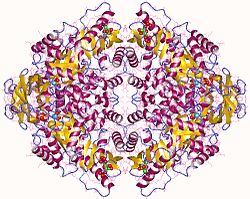Pyruvate kinase
| Pyruvate kinase | ||
|---|---|---|

|
||
| Pyruvate kinase M2 tetramer, Human PDB 1T5A . | ||
| Properties of human protein | ||
| Mass / length primary structure | 543/574/530/530 amino acids | |
| Secondary to quaternary structure | Homotetramer | |
| Cofactor | Magnesium, potassium | |
| Isoforms | L, R, M1, M2 | |
| Identifier | ||
| Gene names | PKLR ; PKM2 | |
| External IDs | ||
| Enzyme classification | ||
| EC, category | 2.7.1.40 , kinase | |
| Response type | Transfer of a phosphate group | |
| Substrate | ADP + phosphoenolpyruvate | |
| Products | ATP + pyruvate | |
The pyruvate kinase (PK) is an enzyme . It transfers a phosphate group from phosphoenolpyruvate to ADP with the formation of pyruvate and thus provides the energy obtained during glycolysis as ATP . Along with hexokinase and phosphofructokinase, Pk is one of the three regulatable enzymes in glycolysis. It is therefore indispensable in the metabolism of all living things. While bacteria have two isoforms of the enzyme, there are four in vertebrates , two of which are encoded by one gene . In humans these genes are called PKLR and PKM2. Mutations in the PKLR gene can cause hemolytic anemia .
The four isoforms are localized in different tissue types: L as the main isozyme in the liver ; R in erythrocytes ; M1 in muscles, heart and brain; and M2 in the fetus .
reaction
Catalysis transfers a phosphate group from phosphoenolpyruvate (PEP) to ADP . It caused ATP and pyruvate . The latter is oxidatively decarboxylated via the pyruvate dehydrogenase complex to acetyl-CoA , which is further broken down in the citric acid cycle . However, this does not result in pyruvate directly, but rather the equilibrium enolpyruvate. At pH 7 the equilibrium is on the side of the keto form. The keto-enol tautomerism takes place spontaneously
( = -35 to -40 kJ / mol) and is largely responsible for the change in free energy due to the hydrolysis of PEP.
For thermodynamic reasons, gluconeogenesis cannot proceed via pyruvate kinase (as in glycolysis) and therefore the enzymes pyruvate carboxylase , which provides oxaloacetate for the first step of the citric acid cycle ( anaplerotic reaction ), and phosphoenolpyruvate carboxykinase are used.
structure
Human pyruvate kinase is a tetramer , consisting of four identical protein subunits with 528 amino acids each .
There are four isoforms of the enzyme in mammals :
- L in the liver and kidneys
- R in red blood cells
- M1 in muscles, heart, brain, leukocytes and platelets
- M2 in early fetal tissue and in tumor tissue
L and R as well as M1 and M2 are each derived from the same gene, but are transcribed by different promoters .
Regulation of pyruvate kinase
Both forms of pyruvate kinase are activated by fructose-1,6-bisphosphate. Fructose-1,6-bisphosphate is formed in the third reaction of glycolysis, which is catalyzed by phosphofructokinase . This reaction, the so-called committed step , determines the reaction speed of glycolysis through its reaction product, fructose-1,6-bisphosphate, which acts as an activator for the next and last reaction in glycolysis. This regulation enables homeostasis of the intermediate products of glycolysis.
Pyruvate kinase is inhibited by a high energy charge in the cell (high ATP concentration) and the presence of alanine . Thus, the reaction does not take place if no further energy is required from the cell.
The L-isozyme is also controlled by protein phosphorylation . If the glucose level in the blood is low, the hormone glucagon causes the phosphorylation of pyruvate kinase, which then loses activity. In this way, phosphoenolpyruvate is retained and is available for gluconeogenesis , through which new glucose is built up in the liver. Intracellular calcium also causes pyruvate kinase to phosphorylate.
Pyruvate kinase defects
The PKLR gene is located on the gene locus 1q22 ( chromosome 1 ). Mutations are only known from the PKLR allele of pyruvate kinase, and only in the R form do these show up as defects. PKR-deficient ( Pyruvatkinasemangel PK) is an autosomal - recessive inherited metabolic disorder . This often causes hemolytic anemia because the red blood cells cannot make enough ATP for their diaphragm pumps. Excess PKR activity with a correspondingly increased ATP in blood cells is known to be a further defect.
Individual evidence
- ↑ a b Degradation and synthesis of glucose - knowledge for medical professionals. Retrieved March 6, 2020 .
- ↑ a b c UniProt P30613
- ^ David Nelson, Michael Cox: Lehninger Biochemie. Springer, Berlin; 4th, completely revised u. exp. Edition. 2008, ISBN 978-3-540-68637-8 , p. 713.
- ^ Reginald H. Garrett, Charles M. Grisham: Biochemistry . Cengage Learning, 2008, ISBN 978-0-495-10935-8 , pp. 551 ( limited preview in Google Book search).
- ↑ G. Valentini, LR Chiarelli et al. a .: Structure and function of human erythrocyte pyruvate kinase. Molecular basis of nonspherocytic hemolytic anemia. In: The Journal of biological chemistry. Volume 277, Number 26, June 2002, pp. 23807-23814, ISSN 0021-9258 . doi: 10.1074 / jbc.M202107200 . PMID 11960989 .
- ↑ Entry on pyruvate kinase. In: Römpp Online . Georg Thieme Verlag, accessed on September 13, 2013.
- ↑ PKLR in the human database HGNC
- ↑ Todd A. Swanson, Sandra I. Kim and Marc J. Glucksman: BRS Biochemistry, Molecular Biology, and Genetics . Lippincott Raven; 5th edition 2010; ISBN 978-0-7817-9875-4 ; P. 68





